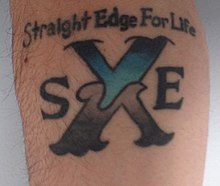
Straight edge (sometimes abbreviated as sXe or signified by XXX or simply X) is a subculture of hardcore punk whose adherents refrain from using alcohol, tobacco, and recreational drugs in reaction to the punk subculture's excesses.[1][2][3] Some adherents refrain from engaging in promiscuous or casual sex, follow a vegetarian or vegan diet and do not consume caffeine or prescription drugs.[4] The term "straight edge" was adopted from the 1981 song "Straight Edge" by the hardcore punk band Minor Threat.[5]
The straight-edge subculture emerged amid the early-1980s hardcore punk scene. Since then, a wide variety of various beliefs and ideas have been associated with the movement, including vegetarianism and animal rights.[6][7] While the commonly expressed aspects of the straight edge subculture have been abstinence from alcohol, nicotine, and illegal drugs, there have been considerable variations. Disagreements often arise as to the primary reasons for living straight edge. Straight edge politics vary, from explicitly revolutionary to conservative. Some activists have approached Straight Edge with skepticism, ridicule or even outright hostility in part due to what they perceived as the straight edge movement's self-righteous militancy.[8]
In 1999, William Tsitsos wrote that Straight Edge had gone through three eras since its founding in the early 1980s.[9] Bent edge began as a counter-movement to straight edge by members of the Washington, D.C., hardcore scene who were frustrated by the rigidity and intolerance in the scene.[10] During the youth crew era, which started in the mid-1980s, the influence of music on the straight edge scene was at an all-time high. By the early 1990s, militant straight edge was a well-known part of the wider punk scene. In the early to mid-1990s, straight edge spread from the United States to Northern Europe,[11] Eastern Europe,[12] the Middle East,[13] and South America.[14] By the beginning of the 2000s, militant straight-edge punks had largely left the broader straight-edge culture and movement.[15]
- ^ Haenfler, Ross (2015). "Straight Edge". In Parmar, Priya; Nocella, II, Anthony J.; Robertson, Scott; Diaz, Martha (eds.). Rebel Music: Resistance through Hip Hop and Punk. Charlotte, North Carolina: Information Age Publishing. pp. 137–138. ISBN 978-1-62396-910-3.
- ^ "Straight Edge Punk | Exclaim!". Straight Edge Punk | Exclaim!. Retrieved 2024-01-26.
- ^ Krist, Josh (22 August 1996). "White Punks on Hope". Phoenix New Times. Archived from the original on 10 August 2011. Retrieved 22 February 2010.
- ^ "Straight Edge Punk | Exclaim!". Straight Edge Punk | Exclaim!. Retrieved 2024-01-26.
- ^ Cite error: The named reference
Encyclopedia of Punkwas invoked but never defined (see the help page). - ^ Wood 1999, pp. 130–140
- ^ Wood 1999, pp. 141–143
- ^ Kuhn 2010, p. 14
- ^ Cite error: The named reference
wtsitsoswas invoked but never defined (see the help page). - ^ Andersen & Jenkins 2003, p. 125
- ^ Kuhn 2010, p. 121
- ^ Kuhn 2010, p. 132
- ^ Kuhn 2010, p. 112
- ^ Kuhn 2010, p. 66
- ^ Haenfler 2006b, pp. 16–17